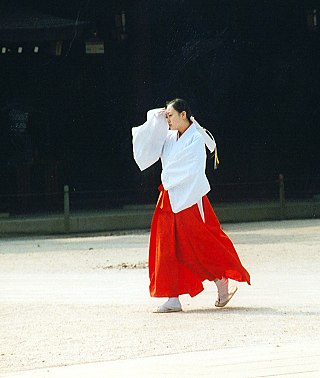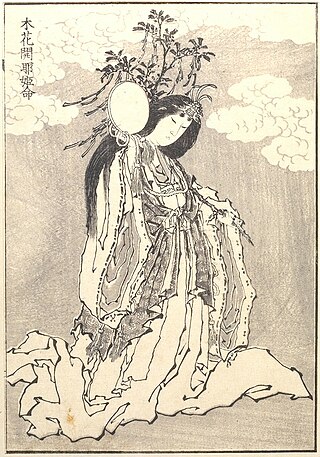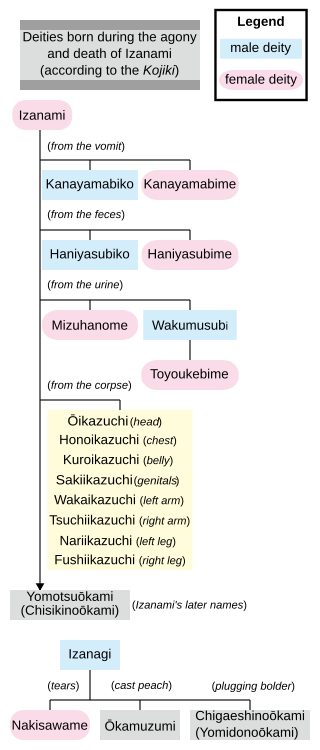Nobuyo Otagaki is a Shinto priest at the Amagasaki Ebisu Shrine in Amagasaki, Hyogo Prefecture, Japan. She has been a resident priest since 2008, taking over from her father as chief priest in 2012. [1]
Nobuyo Otagaki is a Shinto priest at the Amagasaki Ebisu Shrine in Amagasaki, Hyogo Prefecture, Japan. She has been a resident priest since 2008, taking over from her father as chief priest in 2012. [1]
Otagaki was born in Japan in 1971, attended and graduated from Ritsumeikan University in Kyoto. After working for 6 years as a flight attendant, Otagaki began to study Shinto and replaced her father in the Chief Priesthood position in 2012. [2] She does social work for the shrine, often meeting with students to discuss Shinto culture or nutrition. [3] Otagaki also runs a program in which groups get to tour the shrine and learn about Miko life. [4]

Emperor Suinin, also known as Ikumeiribikoisachi no Sumeramikoto (活目入彦五十狭茅天皇) was the 11th legendary Emperor of Japan, according to the traditional order of succession. Less is known about Suinin than his father, and likewise he is also considered to be a "legendary emperor". Both the Kojiki, and the Nihon Shoki record events that took place during Suinin's alleged lifetime. This legendary narrative tells how he ordered his daughter Yamatohime-no-mikoto to establish a new permanent shrine for Amaterasu, which eventually became known as the Ise Grand Shrine. Other events that were recorded concurrently with his reign include the origins of Sumo wrestling in the form of a wrestling match involving Nomi no Sukune.

A priest is a religious leader authorized to perform the sacred rituals of a religion, especially as a mediatory agent between humans and one or more deities. They also have the authority or power to administer religious rites; in particular, rites of sacrifice to, and propitiation of, a deity or deities. Their office or position is the "priesthood", a term which also may apply to such persons collectively. A priest may have the duty to hear confessions periodically, give marriage counseling, provide prenuptial counseling, give spiritual direction, teach catechism, or visit those confined indoors, such as the sick in hospitals and nursing homes.

Shinto is a religion originating in Japan. Classified as an East Asian religion by scholars of religion, its practitioners often regard it as Japan's indigenous religion and as a nature religion. Scholars sometimes call its practitioners Shintoists, although adherents rarely use that term themselves. There is no central authority in control of Shinto, with much diversity of belief and practice evident among practitioners.

Yasukuni Shrine is a Shinto shrine located in Chiyoda, Tokyo. It was founded by Emperor Meiji in June 1869 and commemorates those who died in service of Japan, from the Boshin War of 1868–1869, to the two Sino-Japanese Wars, 1894–1895 and 1937–1945 respectively, and the First Indochina War of 1946–1954, including war criminals. The shrine's purpose has been expanded over the years to include those who died in the wars involving Japan spanning from the entire Meiji and Taishō periods, and the earlier part of the Shōwa period.

Inari Ōkami, also called Ō-Inari (大稲荷), is the Japanese kami of foxes, fertility, rice, tea, sake, agriculture and industry, and general prosperity and worldly success, and is one of the principal kami of Shinto. The name Inari can be literally translated into "rice-bearer". In earlier Japan, Inari was also the patron of swordsmiths and merchants. Alternatingly-represented as male and/or female, Inari is sometimes seen as a collective of three or five individual kami. Inari appears to have been worshipped since the founding of a shrine at Inari Mountain in 711 CE, although some scholars believe that worship started in the late 5th century.

The Ise Shrine, located in Ise, Mie Prefecture of Japan, is a Shinto shrine dedicated to the solar goddess Amaterasu. Also known simply as Jingū (神宮), Ise Shrine is a shrine complex composed of many Shinto shrines centered on two main shrines, Naikū (内宮) and Gekū (外宮).

A miko, or shrine maiden, is a young priestess who works at a Shinto shrine. Miko were once likely seen as shamans, but are understood in modern Japanese culture to be an institutionalized role in daily life, trained to perform tasks, ranging from sacred cleansing to performing the sacred Kagura dance.

Sayako Kuroda, formerly Sayako, Princess Nori, is the youngest child and only daughter of Emperor Emeritus Akihito and Empress Emerita Michiko, and the younger sister of the current Emperor of Japan, Naruhito. She is an imperial Shinto priestess of the Ise Grand Shrine, currently serving as the Supreme Priestess.

Konohanasakuya-hime is the goddess of Mount Fuji and all volcanoes in Japanese mythology; she is also the blossom-princess and symbol of delicate earthly life. She is often considered an avatar of Japanese life, especially since her symbol is the sakura.

State Shintō was Imperial Japan's ideological use of the Japanese folk religion and traditions of Shinto. The state exercised control of shrine finances and training regimes for priests to strongly encourage Shinto practices that emphasized the Emperor as a divine being.

Harvest Festival is a fertility festival celebrated every year on March 15 in some locations in Aichi Prefecture, Japan. Hōnen means prosperous year in Japanese, implying a rich harvest, while a matsuri is a festival. The Hōnen festival and ceremony celebrate the blessings of a bountiful harvest and all manner of prosperity and fertility.

Sanja Matsuri, or Sanja Festival, is one of the three largest Shinto festivals in Tokyo. It is considered one of the wildest and largest in Japan. The festival is held in honor of Hinokuma Hamanari, Hinokuma Takenari, and Hajino Nakatomo, the three men who established and founded the Sensō-ji Buddhist temple. Sanja Matsuri is held on the third weekend of every May at Asakusa Shrine. Its prominent parades revolve around three mikoshi, as well as traditional music and dancing. Over the course of three days, the festival attracts 1.5 to 2 million locals and tourists every year.

Toyouke-hime is the goddess of agriculture, industry, food, clothing, and houses in the Shinto religion. Originally enshrined in the Tanba region of Japan, she was called to reside at Gekū, Ise Shrine, about 1,500 years ago at the age of Emperor Yūryaku to offer sacred food to Amaterasu Ōmikami, the Sun Goddess.

The Association of Shinto Shrines is a religious administrative organisation that oversees about 80,000 Shinto shrines in Japan. These shrines take the Ise Grand Shrine as the foundation of their belief. It is the largest Shrine Shinto organization in existence.

The controversies surrounding Yasukuni Shrine are related to the choice of Japanese people to visit this Shinto shrine and war museum in central Tokyo. The shrine is based on State Shinto, as opposed to traditional Japanese Shinto, and has a close history with Statism in Shōwa Japan. Most of the dead served the Emperors of Japan during wars from 1867 to 1951 but they also include civilians in service and government officials. It is the belief of Shinto that Yasukuni enshrines the actual souls of the dead, known as kami in Japanese. The kami are honoured through liturgical texts and ritual incantations known as Norito.

Aso Shrine is a Shinto Shrine in Aso, Kumamoto Prefecture, Japan. Aso is one of the oldest shrines in Japan. This shrine holds several Important Cultural Properties, including Ichi-no-shinden (一の神殿), Ni-no-shinden (二の神殿), and Rōmon (楼門). The Aso family in charge of the shrine is said to have the second oldest recorded lineage in Japan after the Imperial family. The Aso Shrine was heavily damaged in the 2016 Kumamoto earthquakes. The shrine's rōmon completely collapsed. The haiden also collapsed.

Gingitsune is a Japanese manga series written and illustrated by Sayori Ochiai. It was serialized in Shueisha's seinen manga magazine Ultra Jump from June 2009 to October 2022, with its chapters collected in 18 tankōbon volumes. It follows Makoto Saeki, the daughter of a shrine priest who can see the shrine's messenger, Gintarou, and the everyday lives of the two as a go-between for the gods and humans. A 12-episode anime television series adaptation by Diomedéa was broadcast from October to December 2013.
Tsuruhime (鶴姫) or Ōhōri Tsuruhime was a Sengoku period female warrior (Onna-musha). She was the daughter of Ōhōri Yasumochi, a chief priest of Ōyamazumi Shrine on the island of Ōmishima in Iyo Province. She went to battle several times, and her claim to divine inspiration coupled with fighting skills has led to her being compared with Joan of Arc. Tsuruhime's legacy established her as one of the most recognizable female warriors in Japanese history.
Women occupy a unique role in the indigenous Japanese traditions of Shinto, including a unique form of participation as temple stewards and shamans, or miko. Though a ban on female Shinto priests was lifted during World War II, the number of women priests in Shinto is a small fraction of contemporary clergy.

San Marino Shrine (サンマリノ神社) is a shrine in Serravalle, Republic of San Marino. It is the first official shinto shrine in Europe supported by the Jinja Honcho when the shrine was established.